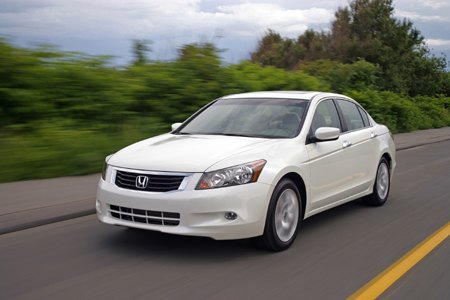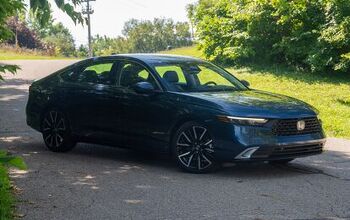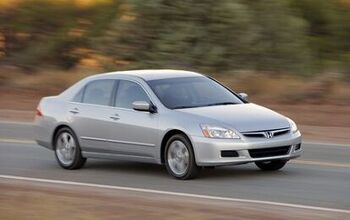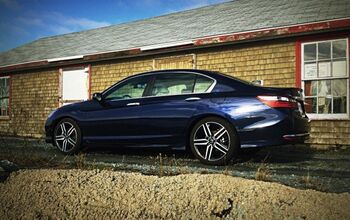Honda Accord Review
I remember sitting in a park with my father a quarter-century ago, pointing at a nearby car. “What do you think that is?” “A BMW?” Nope, but his guess was not without reason. The second-generation Accord lifted more than a few design cues from the storied German marque. The 1982 sedan was also notable for its astounding attention to detail, compactness and efficiency. For those “in the know,” the Accord revealed Detroit’s sedans as over-sized, over-powered and indelicate. Now that Honda’s eighth-generation Accord faces a supposedly chastened Detroit, does the new model maintain the mechanical high ground?
The new Honda Accord is 20 inches longer, eight inches wider, four inches taller and 1,000 pounds heavier than the motor my father misidentified. In other words, it’s larger and heavier than the ‘80’s Detroit iron reviled by Honda’s early fans. And yet the Accord has come full circle. After years of increasingly bland styling, the ubiquitous sedan once again begs to be mistaken for a BMW.
Looking at the new Accord from the rear three-quarter perspective, clocking the C-pillar kink and the wrap-around taillights (that continue to the roofline’s down-sweep), it’s a dead ringer for the current BMW 5-Series. From other perspectives, the Honda’s design is less derivative– and less eye-catching. This despite a swage line slicing downwards from the rear and a bit of Bimmeresque flame surfacing. A distinctly un-Honda abundance of front overhang does nothing for the proportions.
Still, overall, mission accomplished. The new Honda Accord looks much more expensive than both its predecessor and its classmates.
Inside, the Accord’s instrument panel sweeps across the cabin like a 5-Series’ dash. Unfortunately, this aesthetic “homage” extends to the Accord’s ergonomics. The new controls are just as complex as any Bimmer’s, with more buttons than a professional seamstress AND a large iDrive-inspired eight-way knob. So much for “We make it simple.”
The Accord’s front seats are well shaped for both comfort and [a modicum of] lateral support, especially when clad with grippy cloth. Thanks to the supersized external dimensions, the enlarged cabin is roomy enough for four Big and Tall preferred customers. The Accord’s rear seat folds in a single section to expand a class-trailing trunk; unusually intrusive rear strut towers defeat the purpose of a 60/40 split.
The 1982 Accord was motivated by a mere 75 horsepower. For years Honda refused to offer a V6 as a matter of principle. Gen 8 Accord buyers can still opt for a four-cylinder engine, with either 177 horses ( LX) or 190hp (EX). That’s plenty of poke for a family runabout, right? Wrong. Pitted against the upsized Accord’s 3,433-pound curb weight (EX-L with autobox), the four pot must rev its little 16-Valve DOHC i-VTEC® heart out to get the job done. The resulting 21/31 EPA ratings aren’t class-leading.
Enter the new 268-horsepower, 3.5-liter V6. Hello cubes, goodbye revs. Needless to say, the extra displacement works wonders in the oomph department, with minimal torque steer. The six may not deliver neck-snapping thrills or sing a lusty song, but it’s a refined piece that engenders mindless merging and perspiration-free passing.
These powerplants deserve better partners. When hooked up to either engine, the still-five-speed automatics didn’t behave well. They occasionally held a gear too long, or refused to downshift, or bumped when going from gear to gear. Maybe the transmissions needed more miles to adapt to my driving style. Maybe not. Fancy manually shifting the recalcitrant slushbox instead? Buy an Acura.
Though the Accord’s steering feels nicely weighted and precise, the suspension is tuned for touring, not sport. Going around curves, the double wishbones deliver most of the solid, tightly damped and thoroughly composed feel of a BMW– without the Bavarian’s sporting edge. Many competitors offer the option of firmer suspension tuning, but Honda doesn’t believe in options. The Accord’s suspension settings are a deft compromise between comfort and control. They are, nevertheless, a compromise. Enthusiasts will not be well satisfied; everyone else will be.
The Accord’s soft-core suspension settings does have its advantages: banishing the bump-thump busyness that sometimes afflicted the previous Accord on patchy pavement. There’s still more road noise than you’ll find in some Accord alteratives, but it’s much less pronounced than in many past Hondas.
The new Honda Accord is an impressive piece of automotive artistry. It’s well-built, roomy, properly-priced and (with the V6) powerful. It raises Honda’s trademark refinement to a new level, with much of the look and some of the feel of a base BMW 5-Series.
But part of the Accord’s appeal used to lie in Honda’s idiosyncratic insistence on engineering cars that followed the “man maximum, machine minimum” philosophy. The new Accord is large and in charge, but in seeking to provide a 5er for the masses Honda has forsaken much of the formula that earned the model its place in American automotive history.
Michael Karesh lives in West Bloomfield, Michigan, with his wife and three children. In 2003 he received a Ph.D. from the University of Chicago. While in Chicago he worked at the National Opinion Research Center, a leader in the field of survey research. For his doctoral thesis, he spent a year-and-a-half inside an automaker studying how and how well it understood consumers when developing new products. While pursuing the degree he taught consumer behavior and product development at Oakland University. Since 1999, he has contributed auto reviews to Epinions, where he is currently one of two people in charge of the autos section. Since earning the degree he has continued to care for his children (school, gymnastics, tae-kwan-do...) and write reviews for Epinions and, more recently, The Truth About Cars while developing TrueDelta, a vehicle reliability and price comparison site.
More by Michael Karesh
Latest Car Reviews
Read moreLatest Product Reviews
Read moreRecent Comments
- 3-On-The-Tree My experience with turbos is that they don’t give good mpg.
- GregLocock They will unless you don't let them. Every car manufacturing country around the world protects their local manufacturers by a mixture of legal and quasi legal measures. The exception was Australia which used to be able to design and manufacture every component in a car (slight exaggeration) and did so for many years protected by local design rules and enormous tariffs. In a fit of ideological purity the tariffs were removed and the industry went down the plughole, as predicted. This was followed by the precision machine shops who made the tooling, and then the aircraft maintenance business went because the machine shops were closed. Also of course many of the other suppliers closed.The Chinese have the following advantagesSlave laborCheap electricityZero respect for IPLong term planning
- MaintenanceCosts Yes, and our response is making it worse.In the rest of the world, all legacy brands are soon going to be what Volvo is today: a friendly Western name on products built more cheaply in China or in companies that are competing with China from the bottom on the cost side (Vietnam, India, etc.) This is already more or less the case in the Chinese market, will soon be the case in other Asian markets, and is eventually coming to the EU market.We are going to try to resist in the US market with politicians' crack - that is, tariffs. Economists don't really disagree on tariffs anymore. Their effect is to depress overall economic activity while sharply raising consumer prices in the tariff-imposing jurisdiction.The effect will be that we will mostly drive U.S.-built cars, but they will be inferior to those built in the rest of the world and will cost 3x-4x as much. Are you ready for your BMW X5 to be three versions old and cost $200k? Because on the current path that is what's coming. It may be overpriced crap that can't be sold in any other world market, but, hey, it was built in South Carolina.The right way to resist would be to try to form our own alliances with the low-cost producers, in which we open our markets to them while requiring adherence to basic labor and environmental standards. But Uncle Joe isn't quite ready to sign that kind of trade agreement, while the orange guy just wants to tell those countries to GFY and hitch up with China if they want a friend.
- CEastwood Thy won't get recruits who want to become police officers . They'll get nuts who want to become The Green Hornet .
- 1995 SC I stand by my assessment that Toyota put a bunch of "seasoned citizens" that cared not one iota about cars, asked them what they wanted and built it. This was the result. This thing makes a Honda Crosstour or whatever it was look like a Jag E type by comparison.

























![2016 Honda Accord Sedan Review - Quintessential Family Hauler [Video]](https://cdn-fastly.thetruthaboutcars.com/media/2022/07/19/9237516/2016-honda-accord-sedan-review-quintessential-family-hauler-video.jpg?size=350x220)













Comments
Join the conversation
I hope that future models of the Accord are designed better than the '03. Like the previous generation, the seventh generation Accord has significant transmission design problems. Consumers should stay away from the Honda brand until they begin to rectify these issues not only in newer models, but it older ones as well. It is a shame that Honda only works with their customers when under the direction of a court settlement. Like Accords of the "sixth generation", the seventh generation (2003 to 2007) models have the same transmission problems as their predecessors. As court documents reveal, the transmissions would unexpectedly go directly from fifth gear to second gear in the 2000 and 2001 models(http://www.hondatransmissionsettlement.com/php/pdf/caht1not.pdf). This problem, however, was not corrected and the 2003 model year has suffered from this same problem. My advice: Stay far away from the Honda and the Honda Accord. They are not worth the money or aggravation that they cause.
My 2010 Honda Accord EX was waiting for me all my life! While I was out driving Chevys - my then loyalty to the make of my favorite Nascar drivers, Honda was steadily improving their mainstay family/enthusiast sedan.
Along came model year 2008, almost as big as a contemporary front wheel drive Impala, but I feel roomier inside, not as bulky as the Chevy outside.
My 2010 edition just does everything right - except for maneuverability in tight parking lots. There, it is a BUS, almost making me wish I had looked up Civics on Car Gurus instead. It had 71,700 miles on it when I bought it in 2020. Now, I'm closing in 100,000, and still no major issues.